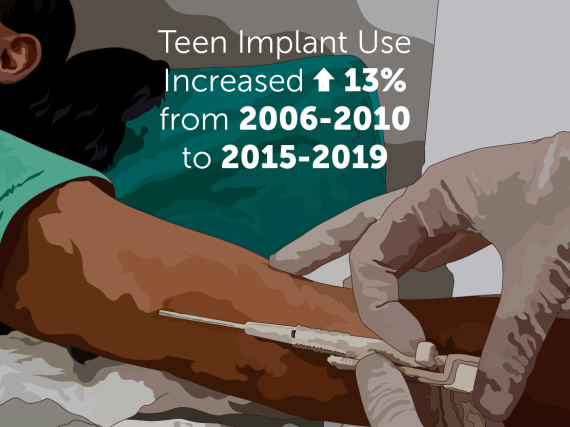2024 Edition of Our Condom Use Data Digest
A year ago I wrote a Condom Use Data Digest in honor of National Condom Day, also known as Valentine’s Day, which highlighted trends from the national Youth Risk Behavior Survey. This year we have new data to present, including findings from recently published National Survey of Family Growth (NSFG) report and Power to Decide’s own 2023 Thanks, Birth Control Survey. These data underscore that condoms are one of the most common methods of birth control people ever use.
According to data from the 2015-2019 NSFG, nearly all (94.5%) sexually experienced women 15-49 years old have ever used a condom with a male partner. This equates to 60.2 million women who have ever used condoms with a partner. Among sexually experienced adolescents 15-19 years old, 95.4% had used a condom at least once in their lifetime.
Looking over time, specifically among adolescents, condoms are the most common contraceptive method used at both first and most recent sexual encounter, and prevalence has remained relatively stable over the past four NSFG time points examined (2002, 2006-2010, 2011-2015, 2015-19). From 2015–2019, 49.7% of sexually active female teenagers reported their partners used a condom the last time they had sex. About one-quarter (22.5%) reported using a condom and a hormonal method of contraception.
Power to Decide collected national data on condom use as part of our 2023 Thanks, Birth Control Survey administered in Fall 2023 with 15-29-year-olds assigned female at birth. Among those who had ever had sex, 85.4% reported ever having used a condom. Among those who had sex in the past 30 days, 31.5% had used condoms in that timeframe.
Even though condoms are a commonly used method, they are not for everyone. Many users and their partners report that condoms reduce sensitivity, and some may encounter challenges negotiating use with their partner, as reflected in NSFG data. Of the women who discontinued using condoms due to dissatisfaction, decreases in sexual pleasure (44.3%) and partner dislike (35.7%) were the most common reasons. From the Thanks, Birth Control survey, 28.7% of those who used condoms in the past month indicated there was a method of birth control they would like to use but were not currently using.
Patient-centered counseling can help address some of the concerns about condoms. I had the privilege of co-authoring the chapter on External (Male) Condoms in the recently released 22nd edition of Contraceptive Technology, which outlines specific strategies providers can use to counsel about condom use, including emphasizing the benefits for sexually transmitted infection (STI) prevention. Additional methods of STI prevention can also be discussed, such as testing, mutual monogamy and pre- and post-exposure prophylaxis.
Because condoms can be used for both pregnancy and STI prevention, they are a unique method of birth control and certainly worth celebrating as part of the full range of contraceptive methods. On this National Condom Day, we say #ThxBirthControl to this important method!



